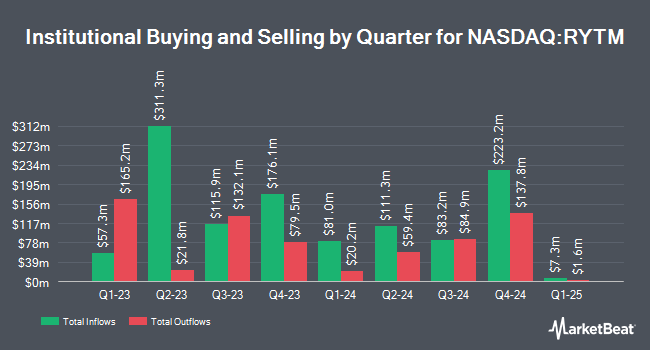Rock Springs Capital Management LP decreased its position in shares of Rhythm Pharmaceuticals, Inc. (NASDAQ:RYTM - Free Report) by 5.3% during the fourth quarter, according to the company in its most recent filing with the SEC. The institutional investor owned 1,162,718 shares of the company's stock after selling 65,375 shares during the quarter. Rhythm Pharmaceuticals makes up 2.5% of Rock Springs Capital Management LP's holdings, making the stock its 10th largest holding. Rock Springs Capital Management LP owned 1.89% of Rhythm Pharmaceuticals worth $65,089,000 at the end of the most recent quarter.
Several other hedge funds also recently bought and sold shares of the company. Marshall Wace LLP lifted its stake in Rhythm Pharmaceuticals by 70.4% in the 4th quarter. Marshall Wace LLP now owns 692,803 shares of the company's stock worth $38,783,000 after purchasing an additional 286,188 shares in the last quarter. Norges Bank bought a new position in Rhythm Pharmaceuticals during the fourth quarter valued at approximately $11,512,000. JPMorgan Chase & Co. increased its stake in Rhythm Pharmaceuticals by 224.3% in the 4th quarter. JPMorgan Chase & Co. now owns 264,585 shares of the company's stock worth $14,811,000 after acquiring an additional 182,993 shares during the last quarter. Walleye Capital LLC bought a new position in shares of Rhythm Pharmaceuticals during the 4th quarter valued at approximately $8,080,000. Finally, Cinctive Capital Management LP purchased a new position in shares of Rhythm Pharmaceuticals in the 4th quarter worth $4,633,000.
Analyst Ratings Changes
Several research analysts recently commented on the company. Bank of America upgraded Rhythm Pharmaceuticals from a "neutral" rating to a "buy" rating and set a $63.00 price target for the company in a research report on Monday, April 7th. Canaccord Genuity Group raised their target price on shares of Rhythm Pharmaceuticals from $81.00 to $92.00 and gave the stock a "buy" rating in a report on Tuesday, April 8th. Wells Fargo & Company boosted their price objective on Rhythm Pharmaceuticals from $80.00 to $91.00 and gave the company an "overweight" rating in a report on Monday, April 7th. Morgan Stanley reiterated an "overweight" rating and set a $72.00 target price on shares of Rhythm Pharmaceuticals in a research report on Friday, March 7th. Finally, Needham & Company LLC reaffirmed a "buy" rating and issued a $66.00 price target on shares of Rhythm Pharmaceuticals in a research note on Tuesday, April 8th. Thirteen equities research analysts have rated the stock with a buy rating, Based on data from MarketBeat, the company has an average rating of "Buy" and an average target price of $74.92.
Read Our Latest Stock Analysis on Rhythm Pharmaceuticals
Insider Buying and Selling
In related news, EVP Yann Mazabraud sold 17,750 shares of Rhythm Pharmaceuticals stock in a transaction dated Tuesday, April 8th. The stock was sold at an average price of $60.99, for a total transaction of $1,082,572.50. Following the completion of the sale, the executive vice president now owns 22,620 shares of the company's stock, valued at $1,379,593.80. The trade was a 43.97 % decrease in their ownership of the stock. The transaction was disclosed in a document filed with the SEC, which is available through this hyperlink. Also, insider Pamela J. Cramer sold 20,760 shares of the stock in a transaction that occurred on Tuesday, April 8th. The stock was sold at an average price of $60.14, for a total transaction of $1,248,506.40. Following the completion of the transaction, the insider now owns 19,209 shares in the company, valued at approximately $1,155,229.26. This trade represents a 51.94 % decrease in their position. The disclosure for this sale can be found here. Insiders sold 146,641 shares of company stock worth $8,112,177 in the last three months. Corporate insiders own 5.60% of the company's stock.
Rhythm Pharmaceuticals Price Performance
NASDAQ RYTM traded up $0.79 during midday trading on Friday, hitting $63.76. 451,624 shares of the company traded hands, compared to its average volume of 550,772. Rhythm Pharmaceuticals, Inc. has a 52 week low of $35.17 and a 52 week high of $68.58. The company's 50-day simple moving average is $55.19 and its 200-day simple moving average is $56.08. The company has a market cap of $4.03 billion, a PE ratio of -14.73 and a beta of 2.32.
Rhythm Pharmaceuticals (NASDAQ:RYTM - Get Free Report) last released its quarterly earnings results on Wednesday, February 26th. The company reported ($0.72) EPS for the quarter, missing the consensus estimate of ($0.69) by ($0.03). Rhythm Pharmaceuticals had a negative net margin of 230.07% and a negative return on equity of 367.36%. The firm had revenue of $41.83 million for the quarter, compared to analysts' expectations of $38.48 million. On average, research analysts predict that Rhythm Pharmaceuticals, Inc. will post -4.32 earnings per share for the current year.
About Rhythm Pharmaceuticals
(
Free Report)
Rhythm Pharmaceuticals, Inc, a commercial-stage biopharmaceutical company, focuses on the rare neuroendocrine diseases. The company's lead product candidate is IMCIVREE (setmelanotide), a rare melanocortin-4 receptor for the treatment of pro-opiomelanocortin (POMC), proprotein convertase subtilisin/kexin type 1, leptin receptor (LEPR) deficiency obesity, and Bardet-Biedl and Alström syndrome.
Featured Stories

Before you consider Rhythm Pharmaceuticals, you'll want to hear this.
MarketBeat keeps track of Wall Street's top-rated and best performing research analysts and the stocks they recommend to their clients on a daily basis. MarketBeat has identified the five stocks that top analysts are quietly whispering to their clients to buy now before the broader market catches on... and Rhythm Pharmaceuticals wasn't on the list.
While Rhythm Pharmaceuticals currently has a Buy rating among analysts, top-rated analysts believe these five stocks are better buys.
View The Five Stocks Here
Discover the 10 Best High-Yield Dividend Stocks for 2025 and secure reliable income in uncertain markets. Download the report now to identify top dividend payers and avoid common yield traps.
Get This Free Report
Like this article? Share it with a colleague.
Link copied to clipboard.
